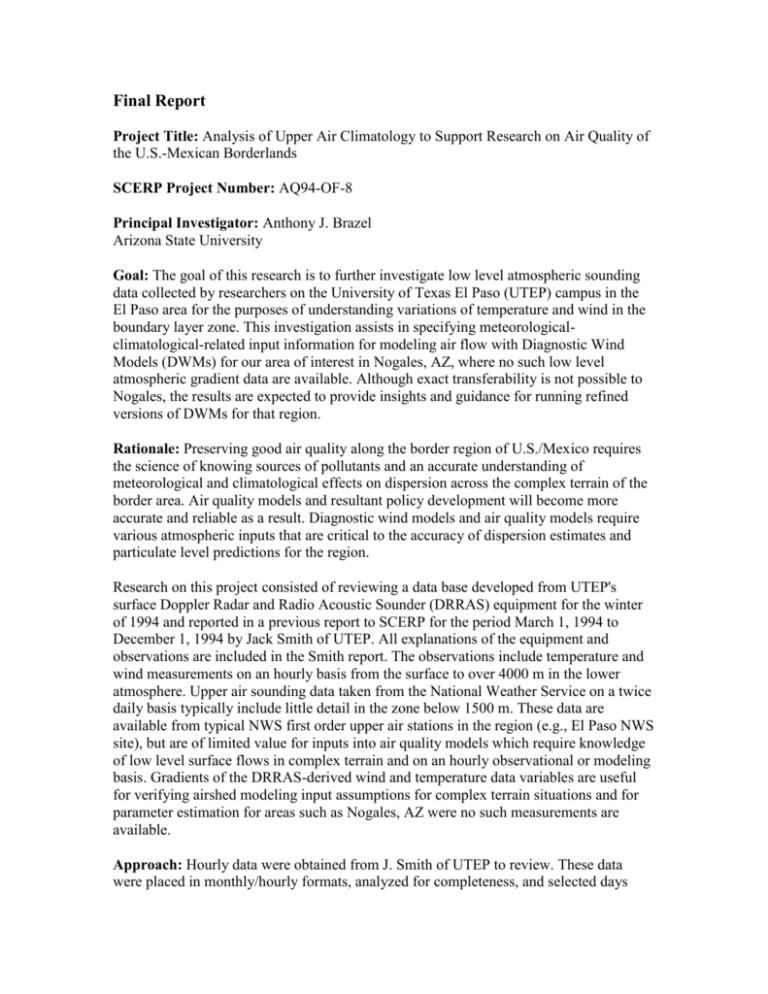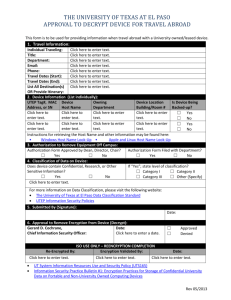Final Report Project Title: Analysis of Upper Air Climatology to
advertisement

Final Report Project Title: Analysis of Upper Air Climatology to Support Research on Air Quality of the U.S.-Mexican Borderlands SCERP Project Number: AQ94-OF-8 Principal Investigator: Anthony J. Brazel Arizona State University Goal: The goal of this research is to further investigate low level atmospheric sounding data collected by researchers on the University of Texas El Paso (UTEP) campus in the El Paso area for the purposes of understanding variations of temperature and wind in the boundary layer zone. This investigation assists in specifying meteorologicalclimatological-related input information for modeling air flow with Diagnostic Wind Models (DWMs) for our area of interest in Nogales, AZ, where no such low level atmospheric gradient data are available. Although exact transferability is not possible to Nogales, the results are expected to provide insights and guidance for running refined versions of DWMs for that region. Rationale: Preserving good air quality along the border region of U.S./Mexico requires the science of knowing sources of pollutants and an accurate understanding of meteorological and climatological effects on dispersion across the complex terrain of the border area. Air quality models and resultant policy development will become more accurate and reliable as a result. Diagnostic wind models and air quality models require various atmospheric inputs that are critical to the accuracy of dispersion estimates and particulate level predictions for the region. Research on this project consisted of reviewing a data base developed from UTEP's surface Doppler Radar and Radio Acoustic Sounder (DRRAS) equipment for the winter of 1994 and reported in a previous report to SCERP for the period March 1, 1994 to December 1, 1994 by Jack Smith of UTEP. All explanations of the equipment and observations are included in the Smith report. The observations include temperature and wind measurements on an hourly basis from the surface to over 4000 m in the lower atmosphere. Upper air sounding data taken from the National Weather Service on a twice daily basis typically include little detail in the zone below 1500 m. These data are available from typical NWS first order upper air stations in the region (e.g., El Paso NWS site), but are of limited value for inputs into air quality models which require knowledge of low level surface flows in complex terrain and on an hourly observational or modeling basis. Gradients of the DRRAS-derived wind and temperature data variables are useful for verifying airshed modeling input assumptions for complex terrain situations and for parameter estimation for areas such as Nogales, AZ were no such measurements are available. Approach: Hourly data were obtained from J. Smith of UTEP to review. These data were placed in monthly/hourly formats, analyzed for completeness, and selected days plotted for analysis of the low level wind and temperature profiles above the surface, especially for suspect days of low flows and synoptically calm periods (periods of importance in air quality analysis in winter). Standard El Paso first order weather station surface data of temperature and wind were merged into the database for comparison with the DRRAS data. Simple case examples of the wind and temperature profiles are presented in this research. All data are submitted in diskette form for researchers, and were graciously and originally provided by Jack Smith of UTEP. Status: Many missing cases exist in the data base, for reasons of instrumental errors and problems occurring in sampling with DRRAS equipment, so that only selected examples of the utility of the data can be presented. Results indicate, for low flow cases (e.g., wind speeds well less than 6 m/s) and for diurnally varying wind in line with local topography in the El Paso region (e.g., ca. SE/NW), that boundary layer wind profiles consistently different below ca. 800 m (roughly terrain obstacle height in the region) than above that level in the free air. An inspection of temperature profiles indicate strong inversions, particularly in AM periods below the 200-400 m above ground level (see examples in Appendix I and II). Inversions are very shallow and show strong gradients below 200 m (+3 degC to + 8 degC/100m) in the morning hours. These results are similar to many measurements of inversions elsewhere in the desert Southwest (e.g., in the Brush Creek Valley of western Colorado taken with tethered balloon, doppler acoustic sounders, and other equipment employed by researchers on ASCOT -- Atmospheric Studies in Complex Terrain). Gradient data of wind and temperature can be merged with synoptic typing schemes for the border region, and these data shed light on assumptions used in DWMs and subsequent air quality modeling with topographic airshed models and complex terrain models. For example, for DWMs, there are requirements to specify domain-scale stability information and surface and upper-air wind data. The specific 10 sample days of DRRAS data used in this study were linked to the synoptic weather catalog for El Paso developed during a previous SCERP project by the authors (Brazel, 1994). The days (selected days in November and December, 1994) consisted generally of high pressure prevalence in the region; which occurs, with the observed temperature and wind characteristics of those sample days in winter, about 15% of the time. The sample days represent the most frequent synoptic type occurring in the El Paso region in winter, especially early winter. Currently, synoptic analyses performed by our group at ASU have been linked to specific runs of DWMs for the Nogales region (Berman, et al, 1995), and will require further verification of hourly estimates of temperature and wind gradient assumptions within and above the boundary layer in order to accurately specify new wind fields and particulate estimates for the border region. Estimates of mixing heights from the selected winter calm periods for the El Paso region from DRRAS data (e.g., 400 m in morning in winter) generally in conformance with those derived from twice daily upper air soundings of the National Weather Service reported for winter morning periods. The DRRAS data, however, allow for hourly inputs for wind and temperature gradients, unlike the NWS data or assumption schemes from these data. Thus, a constant diurnal potrayal of the mixing properties of the lower atmosphere can be rendered and eventually merged with DWM runs. Interpolated temperature gradients from the DRRAS profile data from within a few hundred meters of the surface down to the surface generally produced surface temperature estimates within a degree Celsius of the observed surface observation (shelter height ca. 2 m) at the NWS first order station for early morning and mid-afternoon periods. This is excellent agreement, given the accuracy of the NWS data, the profile data, and the NWS horizontal displacement away from the UTEP DRRAS observation locale. Thus, a combination of the DRRAS data and NWS surface observations may suffice for most applications in specifying the extremely low level inversion characteristics of the boundary layer environment. Practical Use: Wind modeling/air quality assessment approaches, that might require synoptic level inputs to models on an hourly basis and assumptions regarding temperature and wind gradients linked to the boundary layer, could use DRRAS type observations for border region air quality applications. Researchers should replicate and maintain coordinated observational systems such as DRRAS in important drainage ways along the U.S./Mexico border region in the future: (a) to ensure accurate modeling applications requiring hourly inputs and to translate these findings to better development of air quality policy, (b) to link to locally available near-by standard long term climate stations (NWS ASOS, upper air, and others), and (c) to assist in resolving remaining research challenges in understanding low level micro- meso- meteorology and climatology in relation to the complex terrain across the U.S./Mexico border region environment. Other Personnel: We have cooperated with Jack Smith of UTEP on the El Paso region, and are working with G. Hepner and associates at the University of Utah on Nogales. Data Sets The original data sets in Microsoft Excel are available from the Principal Investigator.









